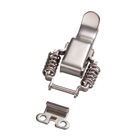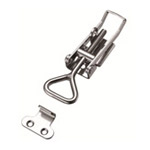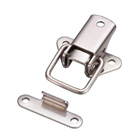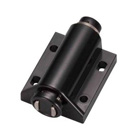Latches are used to keep doors, panels, and general surfaces closed. They're often under-appreciated and extremely useful, both for at-home and industrial uses.
You did think it would be simple to pick a draw latch. But there are a ton of types out there for specific circumstances. With so many types, it is easy to get confused.
We have put together this general guide to help you understand what they are.





















What Are Draw Latches?
Simply put, a draw latch pulls two sides of a surface together in a closing action. This ensures that the surfaces stay firmly closed together.
Why would one need such a mechanism? Its simplicity and effectiveness make it a favorite for a number of applications. For example, use latches for:
- Garden equipment
- Door locks
- HVAC systems
- Exhibits
- Signs
- Agricultural equipment
- Industrial machinery
- Trucks
If you use a latch for your door, you will ensure that the door locks securely. This is great when you need added security.
This goes for applications across industries. Moreover, simply add to any type of surface or machinery. It's versatile and you can add it with little effort.
How Do They Work?
Let's take a moment to dive into mechanics. After all, you will be relying on latches for security.
There are two main items in draw latches that when drawn together, create tension. These two items are the blade and keeper. The blade is a small plate while the keeper is a hooked plate that connects with the blade. In between them less a hinge that keeps these two items firmly together.
This mechanism is often used as secondary or tertiary security precautions. The installation can be horizontal or vertical, depending on what you need to use it for. It can also work well on a variety of surfaces: paint, zinc, steel, and padlocks.
Draw latches, when used properly, reduce the vibration and noise from machines. This protects the quality of the machine. Moreover, protects against ingress (dirt, moisture, etc.). Your home or machines will suffer less when well protected from the outside.
Picking the Right Latch
Draw latches differ in the mechanism by which the latch is closed and the holding type. Moreover, you will find differences in fit and aesthetic as well.
When you have so many choices, it can be hard to choose a suitable solution. It's actually best to ask an experienced hardware supplier to find the best solution for you. This is better than falling back on latches you know or have used in the past.
Even better, there is also an option to use customized draw latches. Having your draw latch customized is acceptable in the industry. It results in the most ideal latch for your surface and goal. For example, your specific application may require a stronger 'grip dimension'. This makes the latch more grip-tolerant and provides a greater degree of adjustment.
Learn More About Draw Latches
Draw latches are actually pretty intricate, as you read above. But their function is simple and effective. When you are in need of safely, firmly, or effectively closing applications, then draw latches can be used as the primary (or secondary) way of keeping them closed.
Do you want to learn more about draw latches? We have some helpful e-catalog pages that provide further information. You can also view our draw latches on our website, and contact our team for support in picking the best one for you!
How they work, and how to pick the best draw latch.
